How to Keep Plants Happy When You’re Busy (Low-Maintenance Plant Guide)

Busy schedule? Forgetful with watering? That doesn’t mean you can’t enjoy lush greenery at home. These low-maintenance indoor plants practically take care of themselves — perfect for anyone juggling work, kids, or a hectic calendar.
Whether you’re a beginner or just burned out on plant drama, this guide will help you keep your plants happy without hovering over them.
Table of Contents
- The Secret to Plant Success: Match Your Plant to Your Lifestyle
- Drought-Tolerant: Built for Skipped Watering Days
- Forgiving with Light: Thriving in Imperfect Spaces
- Slow-Growing: Less Pruning, Less Drama
- Pest-Resistant: Stays Healthy with Minimal Intervention
- Okay With Neglect: Built for Real Life
- Top 6 Low-Maintenance Plants for Busy Lives
- Hacks for Even Less Effort
- ⚠️🐾 Pet Safety Note
- Product Picks for the Busy Plant Parent
- Further Reading
The Secret to Plant Success: Match Your Plant to Your Lifestyle
Most plant problems don’t happen because we’re careless — they happen because the plant’s needs don’t align with how we live.
If you’re a frequent traveler, work long hours, or simply don’t want a plant care schedule that rivals your to-do list, your plants should match your rhythm — not the other way around.

Here are the key traits to look for in a plant that fits a busy life.
Drought-Tolerant: Built for Skipped Watering Days
Plants that can go several weeks without water are ideal for people who travel, forget to check soil moisture, or don’t want to build watering into their weekly routine.
These plants typically have thick leaves, succulent traits, or underground water-storing structures.
Where this is useful:
- In rental flats or dorms where watering schedules may be inconsistent
- For office plants that don’t get weekend care
- In guest rooms or vacation homes you don’t frequent daily
Look for signs like fleshy leaves or upright growth — these often indicate water-storing adaptations.
Forgiving with Light: Thriving in Imperfect Spaces
Not every home has abundant natural light.
Some rooms face north, others are blocked by buildings, and some corners are simply dim.
Forgiving plants can adapt to a wide range of light levels, from shady rooms to occasional direct sun.
Where this is useful:
- Dim corridors or hallways with no direct window access
- Bathrooms with frosted or small windows
- Bedrooms with heavy curtains or blinds
- Studios with only one main source of light
These plants don’t scorch easily, stretch too fast in low light, or throw tantrums when moved. Many will even be fine under LED lamps or grow lights.
Slow-Growing: Less Pruning, Less Drama
Faster growth often means more trimming, repotting, or reshaping.
A slow-growing plant maintains its form for long periods and won’t overwhelm your shelf or pot in a few months.
Where this is useful:
- Small apartments with limited space for large foliage
- Bookshelves, window ledges, or decorative corners where shape matters
- Office spaces where consistent aesthetics are preferred
Less frequent maintenance also means fewer interruptions to your workflow or home flow.
Pest-Resistant: Stays Healthy with Minimal Intervention
Some plants naturally resist common indoor pests like spider mites, mealybugs, or fungus gnats.
These species often have thick leaves, low sap content, or naturally clean growth habits.
Where this is useful:
- In homes where pets, kids, or other plants are sensitive to sprays
- For plant owners who don’t want to deal with sticky traps or pest control routines
- In kitchens or bathrooms where humidity can sometimes attract bugs
Choosing pest-resistant plants minimizes the risk of infestations spreading between your greenery.
Okay With Neglect: Built for Real Life
Perhaps the most important quality — true low-maintenance plants don’t hold grudges.
Miss a watering? No problem.
Forget to rotate them? They’ll be fine.
These plants bounce back with ease and rarely show dramatic signs of stress.
Where this is useful:
- In high-traffic living areas where distractions are frequent
- For new plant parents who are still building confidence
- In multi-use rooms like kitchens or mudrooms where care isn’t a top priority
This trait is the ultimate plant ally for people who want beauty without the babysitting.
Now let’s meet the stars of low-maintenance living.
Top 6 Low-Maintenance Plants for Busy Lives
1. ZZ Plant (Zamioculcas zamiifolia)
A near-indestructible plant known for its upright growth, waxy dark green leaves, and ability to thrive in just about any condition.
It stores water in its thick rhizomes, allowing it to survive weeks without watering — a true set-it-and-forget-it plant.
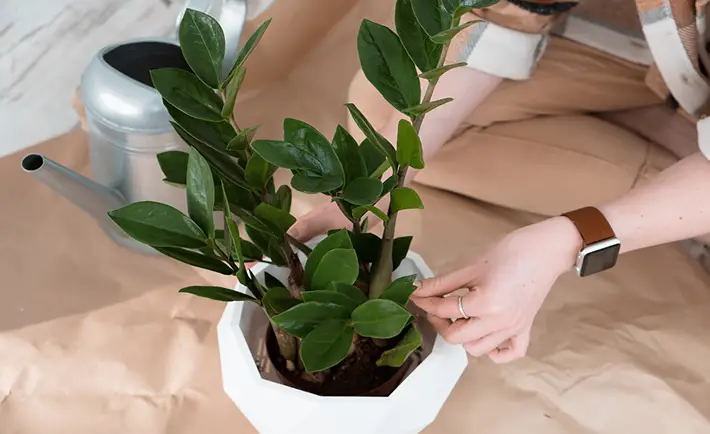
| Care Needs | Details |
|---|---|
| Light | Low to bright, indirect |
| Water | Every 2–3 weeks; let soil fully dry |
| Humidity | Adapts to dry indoor air |
Best placement: Offices, shaded corners, bedrooms. It’s slow-growing and sculptural, perfect for minimal interiors.
2. Snake Plant (Sansevieria trifasciata)
Known as Mother-in-Law’s Tongue, this plant features upright sword-like leaves with striking variegation.
It not only tolerates neglect — it thrives on it.
It’s also one of the few plants that releases oxygen at night, making it ideal for bedrooms.
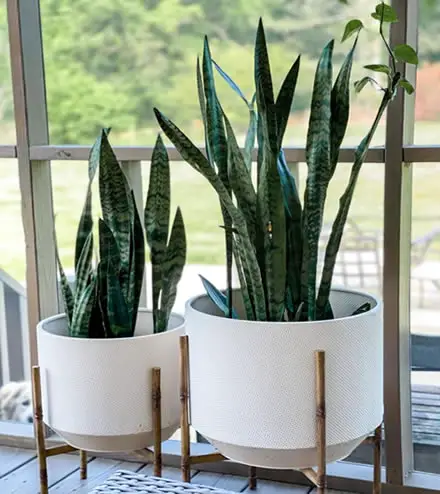
| Care Needs | Details |
| Light | Low light to full sun |
| Water | Every 2–4 weeks; must dry fully |
| Humidity | Low is fine |
Best placement: Bedrooms, entryways, minimalist corners.
Rotate monthly to maintain upright shape.
3. Jade Plant (Crassula ovata)
A symbol of luck and wealth in many cultures, the Jade Plant is a succulent with thick, rounded leaves and woody stems.
Its compact shape and ability to survive with minimal water make it a smart choice for busy homes.

| Care Needs | Details |
| Light | Bright indirect to direct |
| Water | Every 2–3 weeks; dry fully between |
| Humidity | Tolerates dry, indoor air |
Best placement: Windowsills, office desks, kitchens. Can be trained into bonsai form or grown in decorative pots.
4. Cast Iron Plant (Aspidistra elatior)
Named for its sheer toughness, the Cast Iron Plant is a leafy green houseplant that withstands neglect, low light, and wide temperature swings.
Its wide leaves bring old-world elegance and lushness.
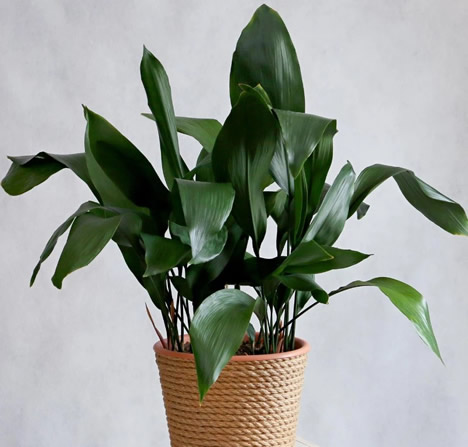
| Care Needs | Details |
| Light | Low to medium; avoid direct sun |
| Water | Every 2–3 weeks; keep evenly moist |
| Humidity | Handles most conditions |
Best placement: Hallways, shaded rooms, dark bedrooms. Resilient even in dry homes or drafty spots.
→ Cast Iron Plant Care: The Nearly Indestructible Houseplant for Low-Light Living
5. Pothos (Epipremnum aureum)
This fast-growing trailing vine is an interior designer favorite for a reason — it brings flow and greenery without the stress.
Though toxic to pets, it’s incredibly forgiving with water and light.
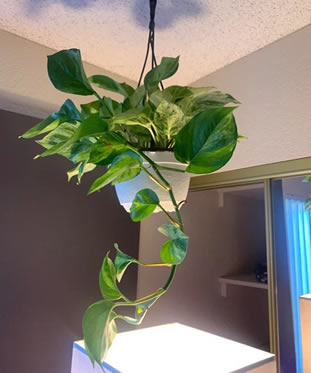
| Care Needs | Details |
| Light | Low to bright; no direct sun |
| Water | Weekly or when top inch is dry |
| Humidity | Medium preferred; tolerates lower |
Best placement: Shelves, hanging baskets, kitchens. Can be trained to climb, drape, or fill wall-mounted planters.
→ Golden Pothos Care: A Trailing Favorite That’s Almost Impossible to Kill
6. Spider Plant (Chlorophytum comosum)
This resilient plant produces beautiful arching leaves and baby “spiderettes” you can replant.
It’s safe for pets and adapts well to varying light and watering schedules.
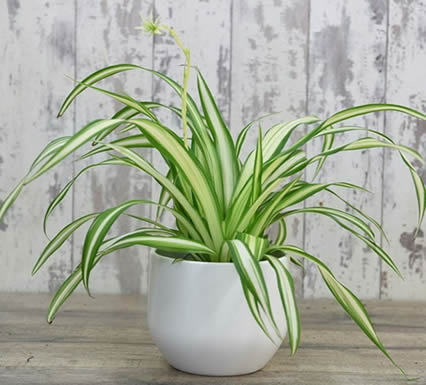
| Care Needs | Details |
| Light | Bright, indirect preferred |
| Water | Weekly or when soil feels dry |
| Humidity | Moderate; tolerates fluctuations |
Best placement: Hanging in kitchens, near windows, or grouped with other plants. Excellent air purifier.
→ Spider Plant Care: How to Grow a Happy, Trailing Houseplant
Hacks for Even Less Effort
- Use a Moisture Meter – Know when to water instantly
- Self-Watering Pots – Great for vacations or travel
- Group by light & humidity – Makes care routines efficient
- Add a timer to grow lights – Automate care in dark rooms
- Use pebbled humidity trays – Passive care with visible impact
⚠️🐾 Pet Safety Note
Not all low-maintenance plants are pet-safe.
✅🐾 Safe: Spider Plant, Cast Iron Plant, Calathea
⚠️🐾 Mildly toxic: ZZ Plant, Jade Plant
⚠️ Toxic: Pothos, Snake Plant
Place toxic plants high or use wall planters in pet-friendly homes.
You can check out our pet safe plants in the category Pet Friendly Plants.
Product Picks for the Busy Plant Parent
- Self-Watering Planter – Keeps roots hydrated without effort
- Digital Moisture Meter – Prevents guesswork and root rot
- All-Natural Succulent Soil – For drought-loving plants like Jade or Snake
- Macramé Hanging Planter Kit – Easy to install, space-saving
- Floating Shelf Trio – Showcase Pothos or Spider Plant with style
Further Reading
→ Pet Safe Indoor Plants That Look Amazing Too
→ House Plant Hacks Every Indoor Gardener Should Know
→ Snake Plant – Why the Snake Plant Helps You Sleep Better at Night
→ Jade Plant – The Jade Plant’s Subtle Strength: Why It Thrives in Kitchens
Thanks for reading! I'm Michael — houseplant fanatic and your Pinterest plant guide.
Follow me on Pinterest for fresh updates 🌿



